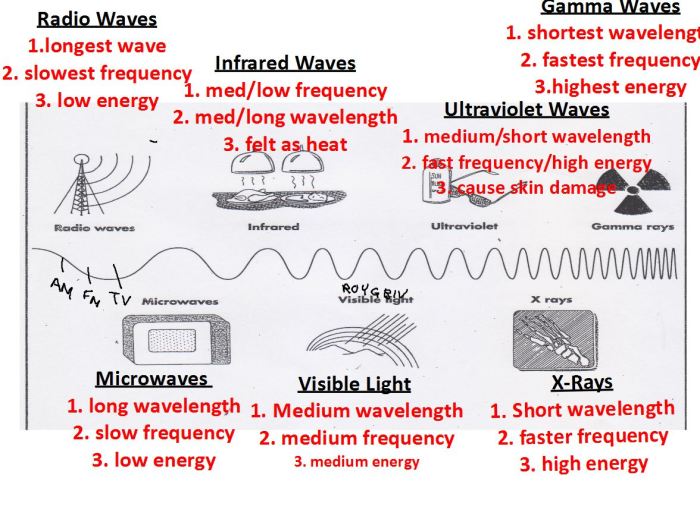Embark on a captivating journey with the Waves and Electromagnetic Spectrum Worksheet, where you’ll unravel the mysteries of the invisible forces that shape our world. From the enigmatic electromagnetic spectrum to the diverse properties of waves, this worksheet promises an immersive exploration into the fundamental building blocks of our universe.
Delve into the nature of waves, their intriguing characteristics, and the intricate relationship they share with the electromagnetic spectrum. Discover the distinct regions of the electromagnetic spectrum and their far-reaching applications, from communication to medicine and beyond.
Electromagnetic Spectrum
The electromagnetic spectrum is a range of all possible frequencies of electromagnetic radiation. It encompasses all types of electromagnetic waves, from the longest wavelengths (lowest frequencies) of radio waves to the shortest wavelengths (highest frequencies) of gamma rays.
Regions of the Electromagnetic Spectrum, Waves and electromagnetic spectrum worksheet
- Radio waves: Longest wavelengths, lowest frequencies; used for communication, navigation, and remote sensing.
- Microwaves: Shorter wavelengths, higher frequencies; used for cooking, radar, and satellite communication.
- Infrared radiation: Shorter wavelengths, higher frequencies; emitted by warm objects; used for thermal imaging and remote sensing.
- Visible light: Shortest wavelengths, highest frequencies visible to the human eye; used for vision and communication.
- Ultraviolet radiation: Shorter wavelengths, higher frequencies; used for disinfection, tanning, and astronomy.
- X-rays: Shorter wavelengths, higher frequencies; used for medical imaging, security screening, and crystallography.
- Gamma rays: Shortest wavelengths, highest frequencies; highly energetic; used for medical imaging, cancer treatment, and nuclear physics.
| Region | Wavelength | Frequency | Applications |
|---|---|---|---|
| Radio waves | 100 km
|
3 kHz
|
Communication, navigation, remote sensing |
| Microwaves | 1 mm
|
300 GHz
|
Cooking, radar, satellite communication |
| Infrared radiation | 1 cm
|
300 THz
|
Thermal imaging, remote sensing |
| Visible light | 700 nm
|
430 THz
|
Vision, communication |
| Ultraviolet radiation | 400 nm
|
750 THz
|
Disinfection, tanning, astronomy |
| X-rays | 10 nm
|
30 PHz
|
Medical imaging, security screening, crystallography |
| Gamma rays | 0.01 nm
|
30 EHz
|
Medical imaging, cancer treatment, nuclear physics |
Waves
Waves are disturbances that propagate energy through a medium or space. They are characterized by their wavelength, frequency, amplitude, and speed.
Types of Waves
- Mechanical waves: Require a medium (e.g., air, water, solid) to propagate; examples include sound waves and water waves.
- Electromagnetic waves: Do not require a medium to propagate; examples include radio waves, microwaves, and visible light.
Relationship between Waves and the Electromagnetic Spectrum
Waves and the electromagnetic spectrum are closely related. All electromagnetic waves are waves, but not all waves are electromagnetic waves. Electromagnetic waves are a specific type of wave that can exist in a vacuum.
The different regions of the electromagnetic spectrum correspond to different wavelengths and frequencies of electromagnetic waves. For example, radio waves have the longest wavelengths and lowest frequencies, while gamma rays have the shortest wavelengths and highest frequencies.
Waves in different regions of the electromagnetic spectrum have different properties and applications. For example, radio waves can penetrate through objects, while gamma rays are highly ionizing.
Worksheet Activities
- Design a worksheet that includes activities for students to explore waves and the electromagnetic spectrum.
- Include activities that involve hands-on experiments, simulations, and research.
Applications of Waves and the Electromagnetic Spectrum: Waves And Electromagnetic Spectrum Worksheet

Waves and the electromagnetic spectrum have a wide range of applications in everyday life.
- Communication: Radio waves, microwaves, and visible light are used for communication purposes, such as radio, television, and the internet.
- Medicine: X-rays and gamma rays are used for medical imaging and cancer treatment, respectively.
- Technology: Microwaves are used in cooking and radar systems, while visible light is used in photography and display technologies.
Essential FAQs
What is the electromagnetic spectrum?
The electromagnetic spectrum is a continuous range of electromagnetic radiation that encompasses all frequencies and wavelengths. It includes radio waves, microwaves, infrared radiation, visible light, ultraviolet radiation, X-rays, and gamma rays.
How are waves related to the electromagnetic spectrum?
Electromagnetic waves are a type of wave that propagates through space and carries electromagnetic energy. They occupy a specific portion of the electromagnetic spectrum, characterized by their frequency and wavelength.
What are the different types of waves?
Waves can be classified into two main categories: mechanical waves and electromagnetic waves. Mechanical waves require a medium to propagate, such as sound waves in air or water waves on the ocean surface. Electromagnetic waves, on the other hand, can travel through a vacuum, such as light waves in space.